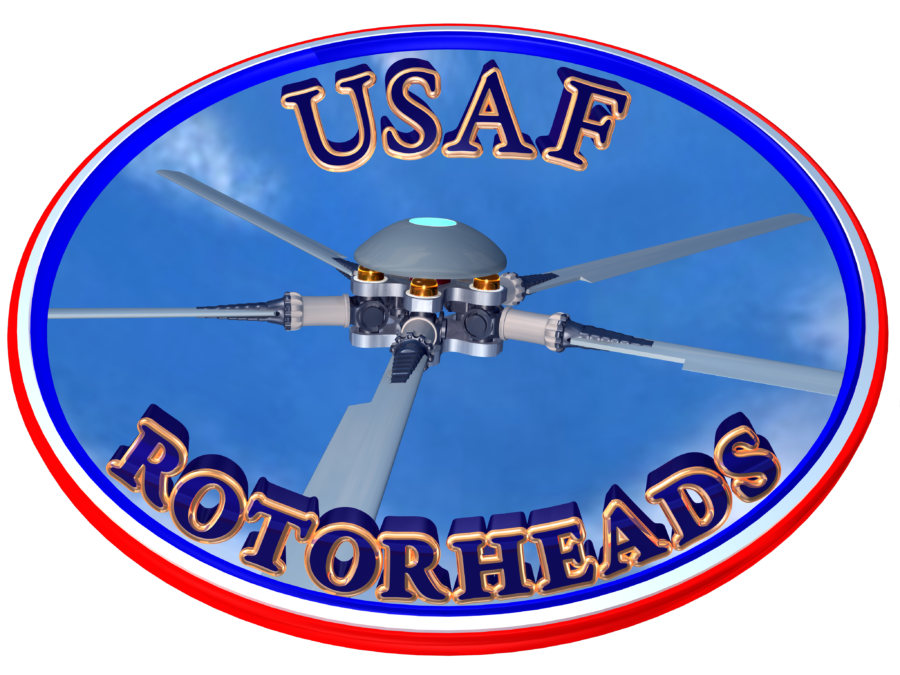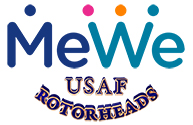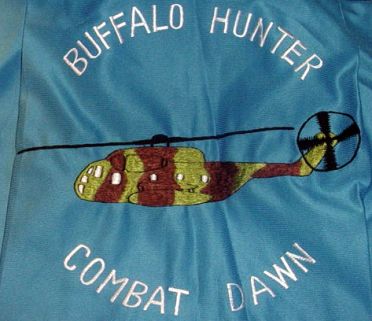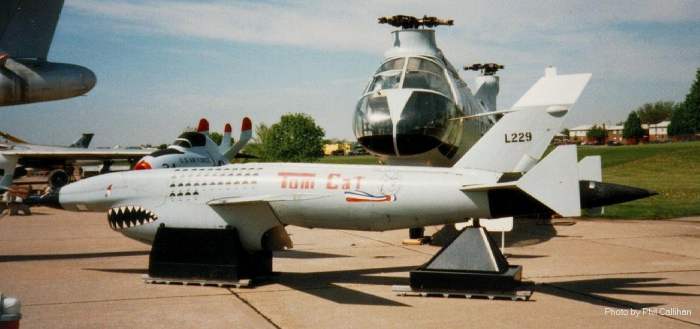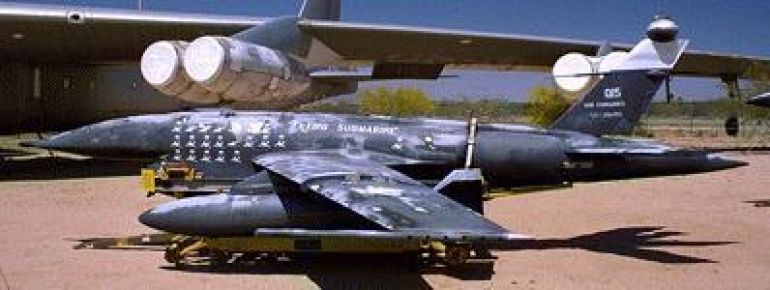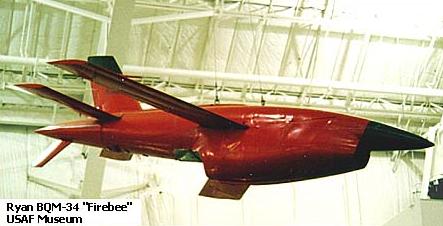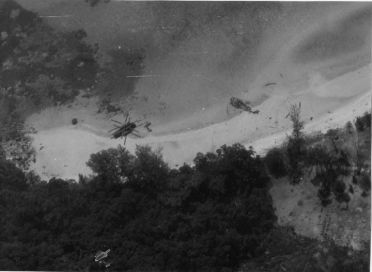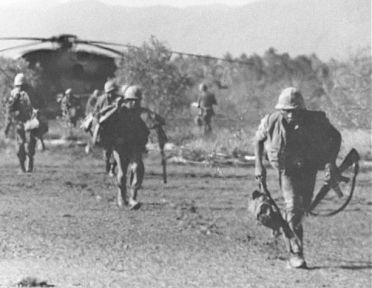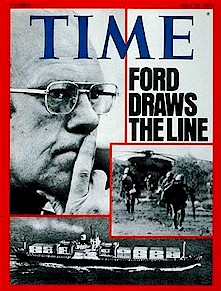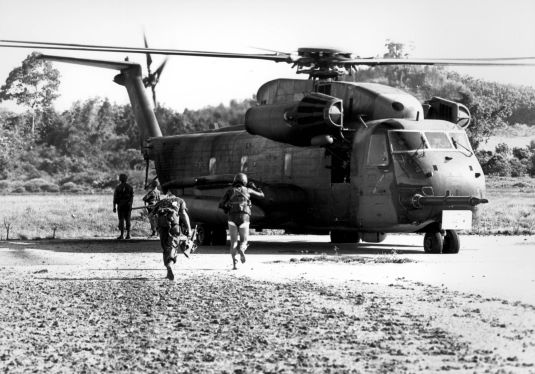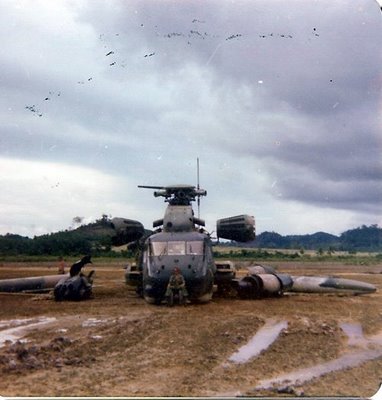Operations
This section consists of "USAF ROTORHEADS" member stories of their participation in the various Operations that Air Force helicopters and helicopter units were involved in.
BUFFALO HUNTER-COMBAT DAWN
|
NOTE: H-53 was placed on jacket should be CH-3C |
|
|
The AQM-34L (Model 147SC) was the definitive low-altitude photo-reconnaissance variant, and by far the most numerous with several hundred built under USAF "Compass Bin" and "Buffalo Hunter" programs. Some AQM-34Ls were equipped with real-time TV camera/transmitter systems, and these were sometimes called AQM-34L/TV. The 147SC was a very successful aircraft with a mission survivability rate of 87.2%, and the AQM-34L named "Tom Cat" completed 68 successful missions.
The AQM-34Q (147TE), built under the USAF's "Combat Dawn" program. It sported numerous bulbs and aerials on its fuselage and flying surfaces. The last AQM-34Qs were fitted with underwing droptanks for longer range, and these tanks were standard on the ultimate "Combat Dawn" version, the AQM-34R (147TF). Otherwise, the AQM-34R was very similar to the -34Q, but had slightly improved SIGINT equipment.
|
|
U.S. Air Force Fact Sheet TELEDYNE RYAN AQM-34Q COMBAT DAWN FIREBEE Firebee drones flew many types of missions, including photographic reconnaissance, electronic intelligence gathering, and radio communications monitoring. From February 1970 to June 1973, AQM-34Q unmanned aircraft flew 268 missions near North Korea monitoring voice communications (known as communication intelligence or COMINT). Code-named "Combat Dawn," the AQM-34Q was developed after North Korean MiGs shot down a U.S. Navy EC-121 reconnaissance aircraft in international airspace with the loss of all 31 crewmembers. Teledyne Ryan built a total of four prototypes and 15 production AQM-34Qs. Launched in mid-air from a modified C-130, the AQM-34Q flew a preprogrammed course or was manually flown by a remote operator. It intercepted radio signals from as far as 300 miles away and relayed them in real time to a ground control van. After returning to a safe area over water, the AQM-34Q deployed a parachute. A modified helicopter then hooked the parachute to catch the drone in mid-air -- if the operation, failed the drone was retrieved from the ocean's surface. The museum's AQM-34Q was nicknamed the Flying Submarine because of the many times it dropped into the ocean. Water recoveries are represented by dolphins and airborne retrievals are represented by parachutes. Placed on display in 2006, it is marked as it appeared in May 1973. "I remember this one well. The reason for the name was the fact that this particular drone seemed to have a liking for swimming. I believe that it was recovered from the ocean at least four times. A picture of the recovery symbols painted on the drone will confirm this. A successful mid air retrieval was shown as a parachute while a swim was shown as a drone nose down in the ocean." ....(John Dorgan) TECHNICAL NOTES: Engine: Continental J100 turbojet engine of 2,800 lbs. thrust "The Combat Dawn program was based out of Osan AB Korea OLOA and was flown with the same CH-3s, but we had long endurance ELINT drones that had a loiter time of up to eight hours off the north coast. It made for a long boring day as we had to cover the launch from the 130s and then go back and sit to wait for the recovery phase. We were tasked directly by NSA."...(John Dorgan) |
Operation EAGLE PULL was the American evacuation by air of Phnom Penh, Cambodia, on April 12, 1975. The plan was developed, starting as early as 1973, and refined as Khmer Rouge (KR) forces closed in on the Cambodian capital city. In a period of less than two hours, Marine Corps CH-53's helicopters transferred 82 Americans, 159 Cambodians, and 35 other nationals to U.S. Navy ships in the Gulf of Thailand. No casualties were sustained in the operation.
Two USAF HH-53C's from the 40th ARRS, staging out of Ubon RTAFB, Thailand, inserted CCT's (combat control teams) into designated LZ's around Phnom Penh before the actual evacuations began. The CCT's along with a airborne USAF HC-130 "King Bird" controlled and directed the flow of helicopters in and out of the capital during the evacuations.
During the evacuations nine CH-53C's of the 21st SOS, staging out of Ubon RTAFB, Thailand, orbited at holding points north of Phnom Penh as backups in the event they were needed. However the USMC CH-53's evacuated all that wanted to be evacuated and the CH-53C's from the 21st SOS did not evacuate anyone and they returned to their staging base in Thailand.
At the end of the evacuations the HH-53C's of the 40th ARRS recovered the CCT's from the designated LZ's around Phnom Penh as well as the last few of the USMC troops that were on the ground to provide security during the evacuations. Both of these HH-53C's were damaged by enemy ground fire during this last task of Operation EAGLE PULL but safely returned to their staging base at Ubon RTAFB, Thailand.
Operation EAGLE PULL information for:
31st MAU
40th ARRS
21st SOS
From date 73-04-13 to 75-04-12
31st MAU was a US Marine Corps unit
40th ARRS was a US Air Force unit
21st SOS was a US Air Force unit
Primary service involved:
US Marine Corps and US Air Force
Operation EAGLE PULL Location - Phnom Penh, Cambodia
Description: The Commander in Chief, Pacific assigned the CG of the 7th Air Force the responsibility for the planning and conduct of the noncombatant emergency evacuation of Cambodia, operation EAGLE PULL. Several options were considered but the planners correctly decided that if fixed-wing aircraft could not use the only major airfield, Pochentong, at Phnom Penh; then long-range CH-53 helicopters would have to be used. At this time the USAF had the 56th SOW and the 3rd ARRG as its primary assets. This included the 21st SOS equipped with CH-53C's and the 40th ARRS with HH-53C's. USAF C-130s would serve as the airborne control. So long as there was sufficient reaction time, the Marine 31st MAU/ARG would provide the security force. The KR started their dry season offensives in early Jan 1974 the American planners continually watched the war in Cambodia and made adjustments to the operation plans.
"We launched out of NKP for Ubon AB the day before. We took all 10 CH-53s from NKP and the 40th went also. We launched out of Ubon early the next morning. We served as a diversion. The Marines left ships in the gulf and picked up the US personnel. Our helicopters picked up some of the marines that were taken in for security during the evacuation.
We returned to NKP flying in a 10-ship formation, trailing smoke from grenades on safety wire from the ramps. I have a copy of the NKP newspaper with a picture covering the whole page of the paper in "V" formation and the whole base saw us."...(Jim Duffy)
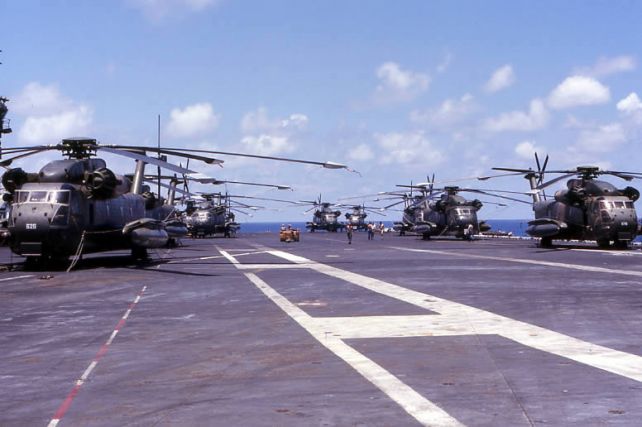 Operation FREQUENT WIND, the evacuation of Vietnam in April 1975, moved over 50,000 people. The initial decision to depart Saigon was made to evacuate the Defense Attaché's office by fixed-wing aircraft. This fixed-wing evacuation was determined impossible when hostile artillery and rocket fire closed the air base at Tan Son Nhut. The decision to evacuate the entire US presence by helicopter under Operation Frequent Wind was made late morning, 29 April 1975, Saigon time. Due to the delayed timing of the order, the capability for rapid response to such an order was imperative. The deteriorating situation at the Defense Attaché location required the Embassy to become a major site.
Operation FREQUENT WIND, the evacuation of Vietnam in April 1975, moved over 50,000 people. The initial decision to depart Saigon was made to evacuate the Defense Attaché's office by fixed-wing aircraft. This fixed-wing evacuation was determined impossible when hostile artillery and rocket fire closed the air base at Tan Son Nhut. The decision to evacuate the entire US presence by helicopter under Operation Frequent Wind was made late morning, 29 April 1975, Saigon time. Due to the delayed timing of the order, the capability for rapid response to such an order was imperative. The deteriorating situation at the Defense Attaché location required the Embassy to become a major site.
The evacuation of the Defense Attaché people proceeded smoothly. Total casualties were relatively light: two USMC Embassy Security Guards killed in an attack by ground fire, and two USMC CH-46 search and rescue helicopter aircrews presumed dead following a crash at sea. Total evacuation helicopter sorties from the US Defense Attaché compound numbered 122. The sorties from the US Embassy numbered 72. The evacuation of 7,806 US citizens and foreign nationals from these two places by the US Air Force and Marine Corps helicopters was supported by a major air effort by the Air Force and Navy. This effort consisted of: 444 USAF/USMC helicopter sorties; 204 TACAIR sorties; 24 AH-1J (Cobra) combat escort sorties; 8 AC-130 gunship sorties; 5 EC-130 (ABCCC) sorties; 44 KC-135 tanker sorties; and 2 HC-130 search and rescue support sorties.
The 9th Marine Amphibious Brigade, a task force of the III MEF successfully extracted by helicopter more than 7,000 Americans and Vietnamese from Saigon, Vietnam, in Operation Frequent Wind. In conjunction with this operation, Marine detachments from III MEF provided security of U.S. ships engaged in carrying Vietnamese refugees to Guam.
ADDITIONAL STORIES AND PICTURES Shipsbouwman.com | FallofSaigon.org
About a week after EAGLE PULL we departed NKP for U-tapao, AB, Thailand we didn't know what was going on until we got to U-tapao. Of course we heard of the events in Viet Nam from our Armed Forces Radio. At any rate we got the aircraft bedded down at U-tapao and we got the word of where we were headed, the aircraft carrier group off the coast of Viet Nam. Just about everyone made a trip to the class 6 store to stock up for the TDY.
We left U-tapao the next morning this must have been around the 18th of April 75, We flew direct to the USS Midway seems to me it took about 8 hours of flying time. We of the 56 SOW had 650 gallon drop tanks versus the 450 on the 40th aircraft so they had to refuel in flight to the Midway.
I flew on the CH-53 with the CO of the 21st Lt. Col John Denham (who incidentally was the wing Stan Eval pilot when I was in 43's at Zaragoza Spain and Bitburg Germany, got a couple check rides with him). When we got on the Midway we found out the Navy was a whole different world than that of the Air Force. They treated us well and we were all assigned to different organizations on the ship that were compatible with our AFSCs.
However we did screw up there whole operation and about ran them out of fresh water the first day we were there. When they had a drill we mostly went the wrong way through the passages and up and down the ladders. It was a great experience and I think just about everyone appreciated the AF a little more after our stay there.
I think we were out there about 12 days before the American ambassador gave us the ok to launch into Viet Nam. Until that day we had a few training flights but mostly sat around after inspecting and re-inspecting and running up the aircraft every few days. Oh the Navy liked us to move the helicopters a lot. We would tow them to the bow, then to the canted deck, then the fantail, then start over again.
And any time there was a black cloud out there in the Gulf they would sail the ship right under it and we would all get wet. We first took 6 CH-53's from the 21st and 4 HH-53's from the 40th. After the 56th got two more aircraft operational they came to the Midway and 2 of the HHs went back to Thailand. The Admiral made the decision after he found out how much more the CH could carry, after all we didn't have PJ's and all their luggage.
I think we stared Frequent Wind on around the 29th, Saigon fell on the 30th. We carried over 2000 people out and my aircraft, with Maj. Carson flying it, flew 20 hours straight. We did hot refueling and running crew changes. One time it landed with 91 or 92 people on it. We didn’t have troop seats and everyone was standing.
We even carried the last of the Marines out, they even had the Embassy shield off the Embassy. Told us they shredded over 6 million in US currency. The civilians were handing out Dong (Vietnam currency) as it was now worthless.
It was a time to be proud to be part of this but at the same time it was sad seeing all these people fleeing for their lives with little or nothing. After the evacuation was over we put all our aircraft towards the bow and the Hueys and Chinooks started coming in. You could not believe it, there were helicopters everywhere.
General Key landed there and one of his Generals walked up to me and asked Air Force? U S Air Force? as I was wearing Jungle fatigues. He just couldn't believe the Air Force was out there.
We even had a Vietnamese 0-2 land on the deck with pilot, wife and 3 or 4 kids in it. It is now at the Pensacola Naval museum. The Midway is a floating Museum in San Diego now and I need to go see her.
The ship sailed to off the coast of Thailand and all told we were on it 18 days. We flew into U-tapao once again and could see the ship sitting off the coast, it was big.
There were planes everywhere at U-tapao, from Viet Nam they flew anything out they could get their hands on. They were on the ramps, in the grass everywhere, have never seen anything like it, C-46, C-47, C-119, C-123’s, commercial aircraft, T-37 and T-38's and many more. There were a lot of Hueys and as soon as a Huey landed painters were out there painting Thai markings on them and flying them out to other bases.
We got the job of slinging T-37 and 38's to the Midway to return to US. After we dropped two in the Gulf they trucked them to Sattihip and hoisted them aboard with cranes. We punched one when the 53 blew a damper and one had the sling break. This was really neat being part of history. Every once in a while I see videos of our helicopters on TV.
The Mayaguez was next. It is hard to believe these same helicopters now called Pave Low are still flying, 32 years later. I hope every one of them gets a reprieve and a home in a museum with the honor they deserve. (Jim Duffy)
During Operation HARDTACK 1 and 2 (1958) there were 62 US atomic weapons fired into the atmosphere, fifteen other devices were detonated underground. The Soviet Union also fired 34 atomic weapons above ground in 1958. The British exploded 5 weapons at Christmas Island. There were 16,000 DOD personnel involved in the US tests.
The 24th Helicopter Squadron (HS)was on of the many organizations that were involved with supporting Operation HARDTACK.
The USAFHPA website has excellent information and pictures of the 24th HS. Fellow Rotorhead Don Damoth is the USAFHPA Webmaster and has put together an excellent article. Don was also a member of the 24th HS during the Pacific tests.
Another fellow Rotorhead, Charlie Nachbar, was a member of the 24th HS during Hardtack. Charlie is a member of the US Atomic Veterans Association and following is a letter he wrote concerning his duty during Hardtack.
From: "Chuck & Sally" cnachbar@hotmail.com
To: pdxavets@aracnet.com
Subject: Operation Hardtack, 1958 "24th Helicopter Sq. USAF"
Date: Thu, 24 Feb 2005
Hi Keith,
My name is Charlie Nachbar. I transfered to Eniwetok in 1958 from Japan with the 24th Helicopter Squadron of the USAF.
I do remember the old B-36 landing and taking off. I think it had a B4 Bag painted on the the nose that said "Have B-36 Will Travel."
We had mostly H-21 helicopters and one H-19 which we lost while I was there. We also lost one of the top atomic scientists with it. It went down at night in shallow water, rolled on it's side and someone opened a 20 man life raft in the cabin trapping the scientest. I think Ron Daniels from Grants Pass Oragon was crew chief of that H-19.
I do remember the great job the US Army did at the mess hall with the steaks on Fridays. The nights spent at Duffies Tavern. Parties over on Japtan, and eating the coconuts before we read the sign by the landing before we went over in the Helicopter, and the old rusted ship left from the war, I think it was the Nickajack Trails and the old cement hull ship in the lagoon we would sometimes land on, the Holmes & Narver mess hall where they served family style dinners and very good pies, fishing was excellent.
I remember seeing through your hands when you didn't have goggles to wear even with your back to the to the blast and when we had tests going on there was no water for showers so they could wash the planes down and taking the pilots out of the sampler planes with a fork lift so they wouldn't touch the plane. When we came back from picking up the instruments after the blast getting another set of shorts and shirt and a good shower.
I also remember the Coconut crabs. and the large Killer clams. They must have weighed 400 lbs. Then there was the giant shark that use to hang out accross the atoll where we were. On a previous test they had blown an island right out of the atoll, nothing left but the water line where the shore use to be.
All in all the experience in the 24th Helicopter Sq Det 4 was something that a very few got to see and hope I never see one of these bombs used again.
I did get to see some of the damage they did in Japan while there in 57 and some of the people they paraded though the streets on May Day.
Well before I write a book I'll save some room for someone else.
Fellow Atomic Vet
Charlie Nachbar
LETTER COURTESY OF CHARLIE NACHBAR
Operation HONEY BADGER which was to be the second attempt to rescue the hostages from Iran in 1981. It was called off when the hostages were released and it was no longer necessary.
Within two weeks after the failure of the Iranian hostage crisis rescue mission (Operation EAGLE CLAW), planning for a second mission began in the Pentagon. The first mission failed due to equipment and coordination problems, culminating in the crash, killing eight servicemen, of a RH-53D Sea Stallion helicopter into a parked C-130 in the Iranian desert.
A new organization, the Joint Test Directorate (JTD), was established to assist and support the Office of Secretary of Defense Directorate (OSD) joint planning staff. Under the program name HONEY BADGER, the JTD conducted a series of large-scale joint-force exercises and projects to develop and validate a variety of capabilities that would be available to OSD when mission requirements were identified. JTD trained a large and diverse force of United States Army and United States Air Force special operations, Ranger, and aviation units, but the critical factor remained extracting the rescue force and freed hostages from Tehran. The Credible Sport project, a joint undertaking of the USAF, U.S. Navy, and Lockheed-Georgia, was created within HONEY BADGER to develop a reliable extraction capability. Credible Sport was tasked to create a large "Super STOL" fixed-wing aircraft to extract the rescue team and hostages and overcome the "weak link" in the previous plan, the heavy lift helicopter.
|
"Mayaguez" Assault on Koh Tang Island At 1400 hours on May 12th 1975 the container ship SS Mayaguez was stopped by a warning shot across her bow, about eight miles from Poulo Wai, an island about sixty miles from the coast of Cambodia. Around noon the next day she was anchored off Koh Tang Island, where Air Force and Navy aircraft kept her under constant surveillance (reportedly they were P-3s, F-4Es, F-111As, A-7Ds, and an AC-130H). The ship’s crew was removed around 1900 hours. (COURTESY OF THE TLCB) This article by Bob Blough appeared in The Thailand Laos Cambodia Brotherhood (TLCB) Newsletter, Mekong Express Mail (MEM), Volume 4, Issue 2, June 2003. This article contains information of an Air Force helicopter operation and is a valuable part of our Air Force helicopter history. The TLCB and Bob Blough has granted USAF ROTORHEADS permission to use this story. USAF ROTORHEADS thanks the TLCB with a special thanks to Dave MacDonald, Editor, Mekong Express Mail, TLCB and USAF ROTORHEADS member Bob Blough. CINCPAC Command History | Richard Van De Geer | Helicopter CH-53A 68-10925 | Airman Magazine Story ('76) | Airman Magazine Story ('91)
KIA Major Howard A. Corson, aircraft commander; 2nd Lt. Richard Van de Geer, pilot; SSgt. Jon D. Harston and Sgt. Randy Hoffmaster, both flight engineers; comprised the crew of CH-3C #68-10925, call sign "Knife 31." As the flight approached the beach, the communists opened fire with a withering barrage of heavy weapons and rocket propelled grenades (RPGs). A deadly moving grid of tracers crisscrossed the designated landing zone (LZ). As the two-aircraft flight approached the island, Major Corson's helicopter was hit by ground fire during the initial barrage including a direct hit by a RPG in the left fuel tank that exploded causing a frightening ball of fire. Major Corson fought to keep the helicopter in the air as it came to a hover just offshore. SSgt. Harston and Sgt. Hoffmaster fired their miniguns at enemy positions from inside the cabin inferno. At the same time 1st Lt. Van de Geer fired an M-16 out his open cockpit window as fire burst through the cabin sidewall. Dazed and wounded, with plexiglas and instrument panel ripped away from their mounts in front of them by another RPG round, the flight crew rode their aircraft into the surf 10 meters from the shore. Inside, the men unbuckled their seatbelts and attempted to douse the flames. Ammunition began exploding and the helicopter's magnesium rotor head caught fire. SSgt. Harston, who had already sustained second and third degree burns, appeared from the submerged forward hatch to lead some of the dazed and wounded Marines out. Of the 28 men on board "Knife 31", all but 13 were recovered. Officially, Lt. Van de Geer was the last man to die in the Vietnam War. KIA While off-loading Marines on the Western Beach of Koh Tang Island, Cambodia, in support of the Mayaguez incident, his CH-53C #68-10926, call sign "Knife 21", was hit by ground fire. The pilot managed a single engine takeoff and headed out to sea, skipping along the water, taking on water each time it hit the surface. The helicopter made it nearly a mile off shore when it crashed. The helicopter rolled on its left side and all of the crew managed to exit the helicopter; however, SSgt Rumbaugh disappeared a short time later and is presumed drowned. SSgt Rumbaugh was serving with the 21st SOS at the time of his death, but served with the 20th SOS in 1970-1971. On The Wall Panel 01W Line 132 While enroute to U-Tapao 21st SOS CH-53C #68-10933, call sign "Knife 13" crashed due to Main Rotor Head failure resulting in the death of the five aircrew and the eighteen Secuity Police that were onboard. The five aircrew were: ~ James G. Kays (P) ~ Laurence E. Froehlich (CP) ~ Robert P. Weldon (FE) ~ ~ George E. McMullen (FE) ~ Paul J. Raber (CC) ~ The eighteen Security Police were: ~ Jimmy P. Black ~ Bobby G. Collums ~ Gerald A. Coyle ~ Thomas D. Dwyer ~ Bob W. Ford ~ Gerald W. Fritz ~ ~ Jackie D. Glenn ~ Darrell L. Hamlin ~ Gregory L. Hankamer ~ David A. Higgs ~ Faleagafula Ilaoa ~ Michael D. Lane ~ ~ Dennis W. London ~ Robert P. Mathias ~ William R. McKelvey ~ Edgar C. Moran II ~ Tommy R. Nealis ~ Robert Ross ~ WIA
"AIR FORCE CROSS" DONALD R. BACKLUND Date of Action: May 15, 1975 Citation: Special Order GB-583, 7/14/1975, USAF RICHARD C. BRIMS Date of Action: May 15, 1975 Citation: Special Order GB-583, 7/14/1975, USAF JON D. HARSTON Date of Action: May 15, 1975 Citation: Special Order GB-583, 7/14/1975, USAF ROWLAND W. PURSER Date of Action: May 15, 1975 Citation: Special Order GB-583, 7/14/1975, USAF "THE SILVER STAR" THOMAS J. BATESON, JOHN J. ELDRIDGE, WAYNE L. FISK, BRAD E. MARX, JOSEPH S. STANALAND, TERRY D. OHLEMEIER "Some people have compared this mission to the Son Tay raid," Lt. Col. John Denham, commander of the 21st Special Operations Squadron and pilot of "Knife 21", said to AIRMAN later. "I hope you don't do that. Son Tay was a special situation where crews were handpicked and trained for months to perform an extraordinary task." The Mayaguez incident just happened. We responded with regularly assigned Air Force crewmen and each man accomplished his end of the mission with outstanding success. This shows you what kind of professionals we've got manning our aircraft today."
INTERNET PHOTOS |
|
Knife 22 was one of several CH-53C's from the 21st Special Operations Squadron (SOS) along with HH-53s belonging to Air Rescue (ARRS) that were involved with inserting US Marines on a heavily defended Kho Tang Island on 15 May 1975. The actions of that day are well documented however there is little known about one of the 21st SOS CH-53C's, 68-10928 call sign "Knife 22". "Knife 22" sustained extensive battle damage however the flight crew was able to make it to the mainland before setting down. (Aircraft tail number was confirmed by Norman Paul who was one of the Flight Engineers that day). Aircraft was repaired and returned to flight status. (AIRCRAFT NOW ON DISPLAY AT HURLBERT AIR PARK, DEDICATED 3 DECEMBER 2007) COURTESY OF JIM DUFFY |
|
Bob Blough provided the following list of flight crew members on the Mayaguez Operation: |
|
Knife 13/68-10933 Knife 22/68-10928 Knife 23/70-1627 Knife 31/68-10925 Knife 32/68-10932 Knife 51/68-10927 Knife 52/70-1626 Nail Crews |
Jolly Green 11/68-10364 Jolly Green 12/69-5793 (AM) Jolly Green 12/69-5793 (PM) Jolly Green 13/69-5794 Jolly Green 41/69-5795 Jolly Green 42/69-5785 Jolly Green 43/69-5792 Jolly Green 44/69-5784 Jolly Green 69-5784/69-5786 FCF Crew |
Integrity, Honor, and Respect
Some of the best things cannot be bought, they must be earned
©2023 USAF Rotorheads All Rights Reserved | Financial Statement
